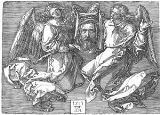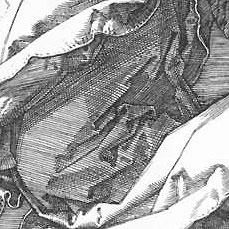
Hatching
Encyclopedia


Drawing
Drawing is a form of visual art that makes use of any number of drawing instruments to mark a two-dimensional medium. Common instruments include graphite pencils, pen and ink, inked brushes, wax color pencils, crayons, charcoal, chalk, pastels, markers, styluses, and various metals .An artist who...
(or painting or scribing) closely spaced parallel lines. (It is also used in monochromatic heraldic representations to indicate what the tincture
Tincture (heraldry)
In heraldry, tinctures are the colours used to emblazon a coat of arms. These can be divided into several categories including light tinctures called metals, dark tinctures called colours, nonstandard colours called stains, furs, and "proper". A charge tinctured proper is coloured as it would be...
of a "full-colour" emblazon
Blazon
In heraldry and heraldic vexillology, a blazon is a formal description of a coat of arms, flag or similar emblem, from which the reader can reconstruct the appropriate image...
would be.) When lines are placed at an angle to one another, it is called cross-hatching.
Hatching is especially important in essentially linear media, such as drawing, and many forms of printmaking
Printmaking
Printmaking is the process of making artworks by printing, normally on paper. Printmaking normally covers only the process of creating prints with an element of originality, rather than just being a photographic reproduction of a painting. Except in the case of monotyping, the process is capable...
, such as engraving
Engraving
Engraving is the practice of incising a design on to a hard, usually flat surface, by cutting grooves into it. The result may be a decorated object in itself, as when silver, gold, steel, or glass are engraved, or may provide an intaglio printing plate, of copper or another metal, for printing...
, etching
Etching
Etching is the process of using strong acid or mordant to cut into the unprotected parts of a metal surface to create a design in intaglio in the metal...
and woodcut
Woodcut
Woodcut—occasionally known as xylography—is a relief printing artistic technique in printmaking in which an image is carved into the surface of a block of wood, with the printing parts remaining level with the surface while the non-printing parts are removed, typically with gouges...
. In Western art, hatching originated in the Middle Ages
Middle Ages
The Middle Ages is a periodization of European history from the 5th century to the 15th century. The Middle Ages follows the fall of the Western Roman Empire in 476 and precedes the Early Modern Era. It is the middle period of a three-period division of Western history: Classic, Medieval and Modern...
, and developed further into cross-hatching, especially in the old master print
Old master print
An old master print is a work of art produced by a printing process within the Western tradition . A date of about 1830 is usually taken as marking the end of the period whose prints are covered by this term. The main techniques concerned are woodcut, engraving and etching, although there are...
s of the fifteenth century. Master ES and Martin Schongauer
Martin Schongauer
Martin Schongauer was a German engraver and painter. He was the most important German printmaker before Albrecht Dürer....
in engraving and Erhard Reuwich
Erhard Reuwich
Erhard Reuwich was a Dutch artist, as a designer of woodcuts, and a printer, who came from Utrecht but then worked in Mainz. His dates and places of birth and death are unknown, but he was active in the 1480s....
and Michael Wolgemut
Michael Wolgemut
Michael Wolgemut was a German painter and printmaker, born in Nuremberg.-Biography:Little is known of Wolgemut's private life...
in woodcut were pioneer
Pioneer
A pioneer is a soldier employed to perform engineering tasks. The term is in principle similar to sapper.Pioneers were originally part of the Artillery branch of European armies. Their primary job was to assist other Arms in tasks such as construction of field fortifications or military camps...
s of both techniques, and Albrecht Dürer
Albrecht Dürer
Albrecht Dürer was a German painter, printmaker, engraver, mathematician, and theorist from Nuremberg. His prints established his reputation across Europe when he was still in his twenties, and he has been conventionally regarded as the greatest artist of the Northern Renaissance ever since...
in particular perfected the technique of crosshatching in both media.
Artists use the technique, varying the length
Length
In geometric measurements, length most commonly refers to the longest dimension of an object.In certain contexts, the term "length" is reserved for a certain dimension of an object along which the length is measured. For example it is possible to cut a length of a wire which is shorter than wire...
, angle
Angle
In geometry, an angle is the figure formed by two rays sharing a common endpoint, called the vertex of the angle.Angles are usually presumed to be in a Euclidean plane with the circle taken for standard with regard to direction. In fact, an angle is frequently viewed as a measure of an circular arc...
, closeness and other qualities of the lines, most commonly in drawing, linear painting and engraving.
Technique
The main concept is that the quantity, thickness and spacing of the lines will affect the brightness of the overall image, and emphasize forms creating the illusion of volumeVolume
Volume is the quantity of three-dimensional space enclosed by some closed boundary, for example, the space that a substance or shape occupies or contains....
. Hatching lines should always follow (i.e. wrap around) the form. By increasing quantity, thickness and closeness, a darker area will result.
An area of shading next to another area which has lines going in another direction is often used to create contrast
Contrast
Contrast may refer to:* Contrast , the difference in color and light between parts of an image* Contrast , expressing distinctions between words...
.
Line work can be used to represent colours, typically by using the same type of hatch to represent particular tone
Tone
- Tone :* Tone , a literary technique which encompasses the attitudes toward the subject and toward the audience implied in a literary work* Tone , the pitch and pitch changes in words of certain languages...
s. For example, red might be made up of lightly spaced lines, whereas green could be made of two layers of perpendicular
Perpendicular
In geometry, two lines or planes are considered perpendicular to each other if they form congruent adjacent angles . The term may be used as a noun or adjective...
dense lines, resulting in a realistic image.
See also
- Dip penDip penA dip pen or nib pen usually consists of a metal nib with capillary channels like those of fountain pen nibs, mounted on a handle or holder, often made of wood. Other materials can be used for the holder, including bone, metal and plastic, while some pens are made entirely of glass...
- PrintmakingPrintmakingPrintmaking is the process of making artworks by printing, normally on paper. Printmaking normally covers only the process of creating prints with an element of originality, rather than just being a photographic reproduction of a painting. Except in the case of monotyping, the process is capable...
- Hatching system (heraldry)Hatching systemThe system of heraldry has two main methods to designate the tinctures of arms in uncolored illustrations: hatching and tricking. Hatching, i.e. patterns of lines and dots, is the most common method to designate colours on uncoloured surfaces, like engravings, seals and coins.The present day...

